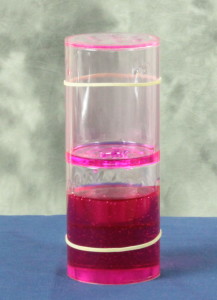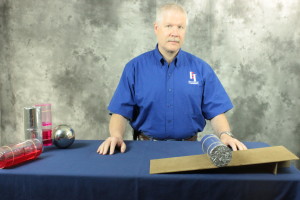 By Ken Byrne
By Ken Byrne
Someone once told me that all magic is science, and all science is magic. To me, a magic show is a series of puzzles for me to solve, trying to figure out just how they pulled off an illusion. My favorite science demonstrations are much the same. I love those demonstrations that make me scratch my head and ask, “Why?”
Here is one of my favorites that is easy and inexpensive. It feels like a magic trick, but it is all science. It simply involves rolling a cylinder down an inclined plane. Sometimes the cylinder will roll down quickly. Other times it will crawl down slowly.
The Soother Ooze Tube Demonstration
Here is what you need:
- An inclined plane of about 6 degrees (also unscientifically referred to as a ‘ramp’)
- Some 3 inch rubber bands
- A 12 x 12 inch square of aluminum foil
- A Soother Ooze Tube (which you can get right here at Educational Innovations)
- Some sort of small, regular ball, such as a marble, a tennis ball, a golf ball…
- A couple of heavy books
 You will notice that inside your Soother Ooze Tube is a thick, viscous, liquid. (The word ‘goo’ is not a very scientific term, but I have found no word that better describes it.) Before you bring this remarkable cylinder into the classroom, spend some time playing with it. You will see that it is made to work like an hourglass. However, instead of sand, it uses that goo. (See, I told you it was a good word!)
You will notice that inside your Soother Ooze Tube is a thick, viscous, liquid. (The word ‘goo’ is not a very scientific term, but I have found no word that better describes it.) Before you bring this remarkable cylinder into the classroom, spend some time playing with it. You will see that it is made to work like an hourglass. However, instead of sand, it uses that goo. (See, I told you it was a good word!)
As you turn over your Soother Ooze Tube, the goo will slowly move from top to bottom, passing through the center opening. It takes about 10 minutes for all the goo to move from one chamber to the other. You may find it mesmerizing to watch the slow motion drips falling as bubbles slowly rise.
Stand the cylinder upright, like a can of soda. Once most of the goo has settled in the bottom chamber, it is time to experiment. Place some heavy books a foot or so from the end of your inclined plane to stop your Soother Ooze Tube from rolling off the table and cracking on the floor. Wrap a couple of rubber bands around it to act as tires, and then place the cylinder on the inclined plane. It should roll down the ramp much as you would expect any round object to do… no surprises there.
 Now, lay your Soother Ooze Tube on its side, horizontally, and wait about five to ten minutes for the goo to settle along one side of the tube. Once it has mostly settled, try rocking it back and forth on your table. Notice that it wants to return to the position with the goo at the lowest point. Move it to the top of your inclined plane and let it go. At first, it may not look like it is moving at all, but keep watching: it will be moving, but very slowly.
Now, lay your Soother Ooze Tube on its side, horizontally, and wait about five to ten minutes for the goo to settle along one side of the tube. Once it has mostly settled, try rocking it back and forth on your table. Notice that it wants to return to the position with the goo at the lowest point. Move it to the top of your inclined plane and let it go. At first, it may not look like it is moving at all, but keep watching: it will be moving, but very slowly.
So why does it do that?
Warning: An in-depth discussion of the obvious follows!
Before we discuss this, let’s ask what seems like an obvious question: Why do round things roll downhill in the first place? We know that they do, but why?
We tend to picture most round objects as having a consistent density. That is, they are made entirely out of the same solid material. Other balls, like tennis balls, are hollow, but have a consistent outer shell. If we took a marble and cut it half, the two pieces, made of solid glass, would have the same mass. If you cut a tennis ball in half, the two pieces, although hollow shells, would also have the same mass. In fact, there is no way you could cut these balls in half through the center point and not have the two halves be the same mass.
If you place a ball on a flat and level surface and look at the bottom, you can see that it contacts the table at the center of the bottom of the ball. With your mind, draw an imaginary line straight up from that contact point and you will see that you have divided it in half. You have the same amount of ball on one side of your imaginary line as the other side. It is balanced. If you turn that ball in any orientation, this is always true… There is no position that you can turn the ball so it is heavier on one side of that contact point than the other. The ball has perfect radial symmetry. As long as it is on a level surface, and it is undisturbed, it will just sit there.
Now place that same ball on your inclined plane and hold it steady. Take a look at the contact point with the inclined plane. It is no longer in the center. If we draw our imaginary line straight up from our contact point, you can see there is more of the ball on the downhill side than the uphill side. More mass for gravity to act upon means more force pulling on the downhill side of the contact point. It is NOT balanced.
Again, if you turn the ball in any orientation, there is always more ball on the downhill side of the contact point than the uphill side. If you release the ball, gravity pulls down with more force on the heavier side than the lighter side, causing it to turn and move down the inclined plane. As we stated before, this imbalance is true regardless of the orientation of the ball, so as the ball turns, there is always more force on the downhill side and it will continue to cause the ball to turn, rolling down the inclined plane until it reaches the bottom and potentially finds a spot where it is balanced.
(I warned you this was obvious, but had you every really thought about it before?)
 When all the goo has settled at one of the round ends of our Soother Ooze Tube, its mass is evenly distributed across its radial axis, and it behaves like the balls described above. If placed on the inclined plane, the downhill side will be heavier, and it will roll right down the ramp, like a marble or a tennis ball.
When all the goo has settled at one of the round ends of our Soother Ooze Tube, its mass is evenly distributed across its radial axis, and it behaves like the balls described above. If placed on the inclined plane, the downhill side will be heavier, and it will roll right down the ramp, like a marble or a tennis ball.
Now, lay your Soother Ooze Tube on a table on its side, horizontally, and wait the five or ten minutes for the goo to settle along one side of the tube. Place it on the inclined plane. It should stop, almost (but not quite) motionless. Look for the contact point, and draw your imaginary line. Notice that there is still more cylinder on the downhill side, BUT MORE GOO ON THE UPHILL SIDE.
The Soother Ooze Tube has found a position where it is balanced. The mass of the cylinder plus goo on the uphill side is equal to the mass of the cylinder plus goo on the downhill side. The force due to gravity is equalized, and the Soother Ooze Tube does not roll.
However, we are not done. The goo inside is a liquid, and liquids seek their own height. Looking in your Soother Ooze Tube, you can see that in order to have more goo on the uphill side, it sits higher than it does on the downhill side.
If this was water, it would immediately flow until the liquid was level. But, our goo is a liquid with a high viscosity. Chemistry defines viscosity as ‘resistance to flow.’ As our goo slooooowly flows to the downhill side, the downhill side becomes heavier, and it rolls down BUT ONLY UNTIL, ONCE AGAIN, THE SLOW MOVING GOO IS HEAVIER ON THE UPHILL SIDE and it slows to a stop. But, our goo continues to slowly flow….. This repeats itself until the Soother Ooze Tube is on a level surface and the goo can level out.
 My favorite way to do this demonstration in the classroom is wrap my Soother Ooze Tube in aluminum foil, completely covering it so the students cannot see the inside. I then wrap my rubber bands around it for a little traction. I ask for predictions of what will happen when I place my cylinder on the ramp.
My favorite way to do this demonstration in the classroom is wrap my Soother Ooze Tube in aluminum foil, completely covering it so the students cannot see the inside. I then wrap my rubber bands around it for a little traction. I ask for predictions of what will happen when I place my cylinder on the ramp.
There is always great surprise when the cylinder moves so slowly. I then casually set it on its end and tell the students to think about it for a few minutes while we work on something else. I then return to it ten minutes later asking once again for predictions. Now they all predict that it will move slowly, but instead it speeds down the ramp. I leave the Soother Ooze Tube sitting horizontally, right where it stopped, and come back to it ten minutes later. Again, it moves slowly. It makes a great (and frustrating) thought puzzle for the students. When I am ready to reveal the secret, I just tear off the aluminum foil.
The Soother Ooze Tube is a great way to introduce many scientific principles in your class. Use it as a demonstration for:
- Center of Gravity
- Fluid Dynamics / Viscosity
- Force and Motion / Newton’s Laws (F=ma or F=mg)
- Simple Machines
I hope you find it as enjoyable as I do watching students thinking really hard about something, and enjoying it. One more bonus: this demonstration gives you one of the best opportunities to use the word ‘goo’ in your classroom!


